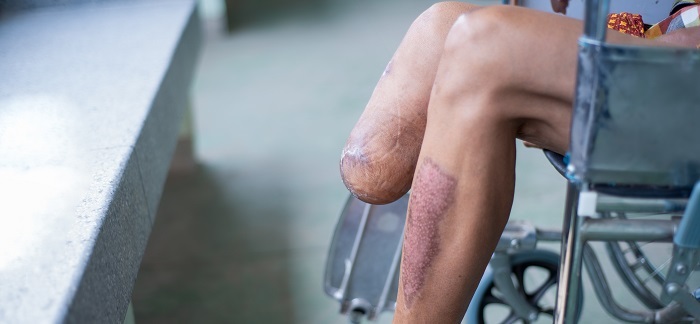
 Data Structure
Data Structure Networking
Networking RDBMS
RDBMS Operating System
Operating System Java
Java MS Excel
MS Excel iOS
iOS HTML
HTML CSS
CSS Android
Android Python
Python C Programming
C Programming C++
C++ C#
C# MongoDB
MongoDB MySQL
MySQL Javascript
Javascript PHP
PHP
- Selected Reading
- UPSC IAS Exams Notes
- Developer's Best Practices
- Questions and Answers
- Effective Resume Writing
- HR Interview Questions
- Computer Glossary
- Who is Who
What is the full form of AKA ?
What is Above the Knee Amputation?
An Above-Knee Amputation- AKA is a process where a part of the leg is removed above the knee surgically .This process is also known as a transfemoral amputation.
Such knee amputation surgery is done strictly in cases where the leg has undergone severe damage by any accidents or disease like gangrene and the part is unable to function properly. Above-knee amputations are also conducted if the part of the leg above the knee has developed any form of infection.

Why Is Above the knee amputation conducted?
This amputation strategy is performed to remove a part of the femur for any tumorous growth to prevent the spread of cancer or Infection. The above-knee amputation is a lacerative procedure which demands a long recovery and a healing time.
Who performs the amputation surgery?
On following conditions above the knee amputation can be undergone ?
Any kind of traumatic injuries to the leg due to accidents.
Infections in the leg that cannot be cured by antibiotics.
Gangrene formation (when body tissue dies due to adequate blood supply)
Anyone with Peripheral artery disease, where plaque develops in the arteries and restricts blood supply to the limbs.
Complications
There can be various complications post-above-knee amputation. They are as follows ?
Infection ? Infection is a common risk and complication that can arise after amputation.It is very much necessary to clean and dress the amputated part everyday.
Severe Bleeding ? Bleeding is widespread after amputation and may demand for blood transfusion if the bleeding is excessive.
Blood clotting ? Blood clots formation is a severe complication in the leg postsurgery and can be dangerous if the clot breaks down and reach lungs
Phantom limb pain sensation ? Phantom limb pain is a post effective surgery pain or a sensation in the amputated part.It feels that the pain is still there.This limb pain is a result of nerve damage while surgery.
Stump sore ? A type of bulged sore on the residual limb and it is very excruciating and may take a long time to heal.
Chronic pain ? This pain is a long lasting pain and it might vary from individual to individual.Some may have it for 6 months while others for years.
Mode of Treatment
There are various treatment options for above-knee amputation and the most common treatment involves surgery.Besides Surgery some other treatment procedures include-prostheses, physiotherapy, and occupational therapy.
Surgery
Surgery is the most common uptake for above-knee amputation.Surgery is done to the diseased or damaged part of the limb to get rid of the infection.The type of surgery to be done depends on the cause of the amputation.
Prosthesis
Prosthesis is an amazing technique where the damaged limb is replaced with an artificial limb and this technique is meant for both upper and lower limbs.The artificial limbs are made from materials like plastic, metals, or any form of composite substance.
Physiotherapy
Physiotherapy is a reliable techniques for improving strength,stretchability and motion range of the patient.It helps to improve the function of the remaining limb as the significant effect falls over the remaining body parts after the amputation.Physiotherapy helps delay the inception of muscle weakness and stiffness of the joint. The therapy involves the following steps ?
Stretching exercises
Muscle strengthening
Body massage
Electrical stimulation of the muscles
Heat/Cold therapy
Acupuncture therapy
A physiotherapist is consulted if a patient has undergone a prosthesis for proper fitting of the artificial limb over the amputated part segment.
Occupational therapy
Occupational therapy is a worthy treatment strategy that helps to improve a patient's daily activities. It lessens the risk of sudden falls and injuries post-surgery.In occupational therapy example, it is suggested to use a wheel-chair or scooter for moving around.It is also advisable to use some specialised devices to help with daily activities like bathing, dressing up, and eating.
Conclusion
The above-knee amputation is a significant injury that may lead to severe complications and death. It is necessary to undergo treatment strategies if anyone is facing such extreme injuries due to accidents. AKA is a costly treatment, in terms of medical expenses and lost efficiency of a body part. Some treatments are successful and life leading becomes routine post surgery, but failure in medical science and amputation can result in an everlasting disability.
FAQs
Q1. What are the different types of amputations?
Ans. According to the doctors there are two categories of amputations-Upper and lower.Upper amputations involve amputating fingers, wrist, or arm while lower amputations work upon toes, ankle, or leg. An amputation is the confiscation of an entire or a body part. A doctor may endorse this treatment approach due to any chronic disorder or traumatic injury.
Q2. Can Injuries and trauma lead to amputations?
Ans. Yes,Injuries and trauma can lead to amputations. Around 5.6 percent of lower limb amputations are associated with severe traumatic injury. The injuries can include car accidents or workplace-related accidents.
Q3. Are there any side effects of amputation?
Ans. There are plenty of after-effects of amputation like altered gravity and balance, high risk of arthritis in remaining body parts because post amputation workload increases of an individual and back pain occur due to changes in the position of the amputated body parts.

